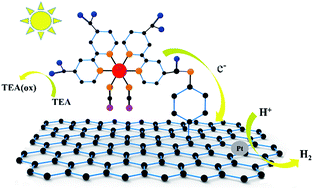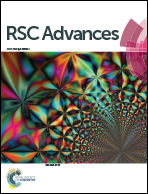A robust and efficient visible light driven photocatalyst for hydrogen evolution based on ruthenium dye N3 covalently immobilized on reduced graphene oxide
Abstract
In this paper, a novel nanohybrid composed of cis-dithiocyanato-bis(2,2′-bipyridine-4,4′-dicarboxylate)ruthenium(II) (N3) covalently functionalized reduced graphene oxide (N3-RGO) has been synthesized. The nanocomposite is characterized by transmission electron microscopy (TEM), Fourier transform infrared (FTIR), Raman spectroscopy, X-ray photoelectron spectroscopy (XPS), fluorescence, and UV-vis spectroscopy. The results demonstrate that the N3 dye molecules have been covalently grafted on the graphene sheets. The efficient fluorescence quenching and the enhanced photocurrent response confirm that the photoinduced electron transfer from the N3 moiety to the graphene sheet and charge recombination have been suppressed. Platinum nanoparticles as cocatalysts loaded on the N3-RGO nanosheets show a remarkable improvement in photocatalytic hydrogen evolution. The amount of hydrogen evolved from N3-RGO/Pt reached 11.25 and 1.78 μmol mg−1 under 7 h of UV-vis and visible light irradiation, respectively. This work provides a new way to design more efficient graphene-based nanocomposite photocatalysts for solar energy conversion.


 Please wait while we load your content...
Please wait while we load your content...